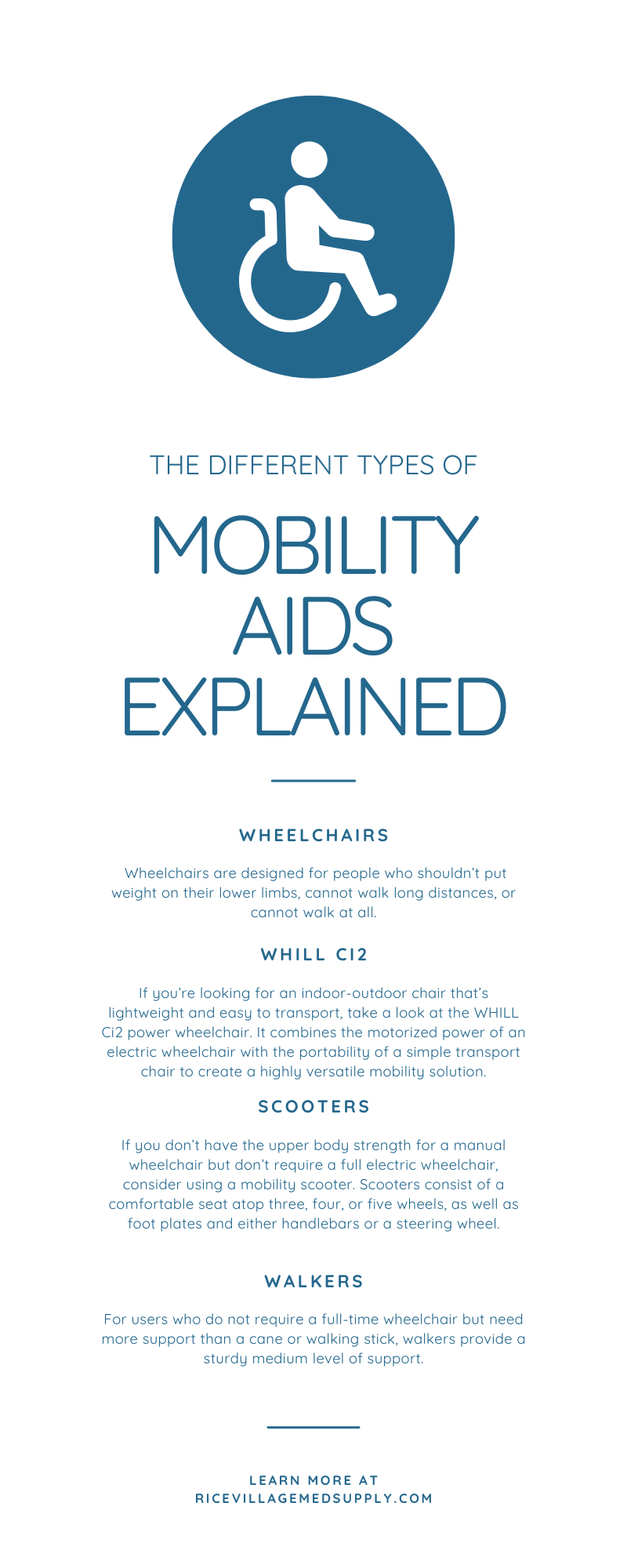|
Are you shopping for a mobility aid but are unsure of which type you need? Rice Village’s handy guide to mobility aids can help you make your choice.
A mobility aid, as its name implies, is designed to help an individual with limited mobility walk or move without excess discomfort. There is a wide variety of mobility aids on the market, each geared toward different limitations. Whether you’re nursing an acute injury back to wellness or live with permanent restrictions to your mobility, there’s an aid out there for you. Rice Village Medical Supply offers a diverse selection of mobility aids for different needs, available both for purchase and for convenient rental. We understand how important it is to keep moving, especially with mobility limitations, and we aim to provide quality solutions for anyone who needs extra help getting around. If you or a loved one has unique mobility needs and is unsure of which aid will work best, keep reading. Rice Village has compiled a thorough guide to explain the different types of mobility aids we offer to help you make your choice. WheelchairsLet’s start with one of the most common mobility aids on the market. Wheelchairs are designed for people who shouldn’t put weight on their lower limbs, cannot walk long distances, or cannot walk at all. Some folks use a wheelchair as they recover from lower limb injuries to avoid putting any stress on the legs or feet. Others use their wheelchairs full-time if their disability prevents them from walking. There are a couple of different styles of wheelchairs that are in common use today. Let’s look at them one at a time. Manual WheelchairsA manual wheelchair advances by the user pushing the wheels forward with their arms. These chairs help the user get around independently and take part in everyday pursuits! Some common types of manual wheelchairs include:
If you need a manual wheelchair for a short period of time, ask Rice Village about our wheelchair rental options. Stay active as you recover without committing to the purchase of specialized mobility equipment! Electric WheelchairsSome people with limited mobility are unable to use a standard wheelchair, so they opt for the power or electric version to get around. An electric wheelchair has a sturdy base that has four or more wheels on it: two for drive and either two or four additional wheels for extra mobility. Depending on the lifestyle of the user, one electric wheelchair may be more useful than another. Certain types of electric wheelchairs have extra-tight turn radiuses, which are great for people who spend most of their time indoors. Others are equipped for indoor-outdoor use and can handle a wide variety of terrains. WHILL Ci2If you’re looking for an indoor-outdoor chair that’s lightweight and easy to transport, take a look at the WHILL Ci2 power wheelchair. It combines the motorized power of an electric wheelchair with the portability of a simple transport chair to create a highly versatile mobility solution. Using a wheelchair shouldn’t confine you to your home or other indoor spaces. The WHILL Ci2 handles well on many types of terrain while keeping you comfortable in a plush padded seat. It’s also highly water resistant, so you needn’t worry about getting caught in the rain or snow. ScootersIf you don’t have the upper body strength for a manual wheelchair but don’t require a full electric wheelchair, consider using a mobility scooter. Scooters consist of a comfortable seat atop three, four, or five wheels, as well as foot plates and either handlebars or a steering wheel. Mobility scooters are highly beneficial for folks who have trouble walking long distances but do not require a wheelchair full-time. If you believe your quality of life will be enhanced with the use of a scooter, take a look at the three main types of scooters:
WalkersFor users who do not require a full-time wheelchair but need more support than a cane or walking stick, walkers provide a sturdy medium level of support. Much like the other mobility aids discussed here, walkers come in a variety of setups to accommodate diverse mobility needs. Standard WalkerThe most common type of walker has four points of contact with the ground, tipped with non-skid rubber tips to prevent its user from falling. You must pick up and place down standard walkers with every step, and you can easily lean on them if you need to stop and rest for a moment. Rollator WalkerIf you are unable to pick up and place down a walker with every step, consider a model with wheels! These are the options:
Knee WalkersIf one of your legs is stronger than the other, or if you are recovering from a lower limb injury that hinders your mobility, consider using a knee walker. These walkers, as their name implies, boast a padded cushion for you to rest a weak knee while you use your stronger leg to propel yourself forward. Are you or a loved one dealing with mobility limitations? Find a solution that best fits your lifestyle and gets you moving again! Now that Rice Village has explained the different types of mobility aids we offer, contact us when you’re ready to start shopping. We care about improving your quality of life while promoting wellness and healing.
0 Comments
Leave a Reply. |
Rice Village Medical SupplyRead our blogs for helpful information on medical supplies today. Archives
March 2023
Categories |


 RSS Feed
RSS Feed